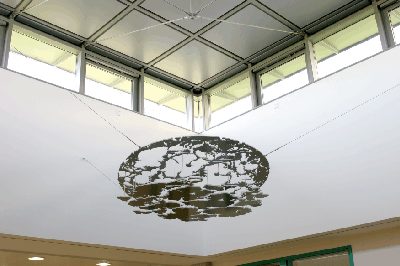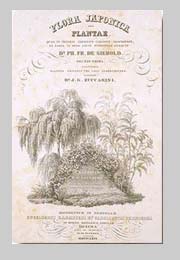| Siebold's Hanging Gardens |
© NELE STROEBEL |
|
|
New surgical and internal medicine building at the Wuerzburg University Clinic, 2004: "Die Hängenden Gärten" (Hanging Gardens)*a three-part installation for the large areals, each 36 sqm, above the waiting areas of the thorax surgery, traumatology and general surgery rooms. |
|
|
Inspired by two of Wuerzburg's important citizens, Carl Casper Siebold, the founder of the surgery department, and his grandson Philipp Franz v. Siebold**, the universalist and Japanologist, I developed three thematic installations for the waiting areas of the thorax, general and traumatology surgery rooms of the Wuerzburg University Clinic. |
|
|
The Siebold family's scientific "cabinets of curiosities" as well as the surgery department's "suture material lab" are represented by three metal works hung in the areals:
These installations float in the areals underneath the skylights, which are covered with real plants. Their concentric or dialogically open surfaces are stretched to form three-dimensional bodies. Their structure and development reflect surgical methods (old Greek: 'working by hand'). About the picture: |
 |
Surgery(old Greek: 'working by hand') includes the areas of vascular and thorax surgery, traumatology and abdominal surgery. Heart surgery, neurosurgery and plastic/cosmetic surgery are independent disciplines. Surgery is operational, i.e. "cutting" medicine. In surgery, medical treatment is carried out by means of operations. Diseased organs or parts of organs are removed, incorrectly located organ systems are restored to their correct places and new organs or prostheses implanted. Traumatology concerns itself with operative reconstruction. The suture material lab of Wuerzburg's operative surgery departmentEvaluating materials used to close wounds requires objective judgment of a suture thread's various characteristics. But because the value of such a material can first be seen in use, it also makes sense to evaluate the subjectively felt qualities reported by the surgeon and analyze these. Any evaluation, however, is made all the more difficult, however, by the dependence of the suture on different places and milieus in the body, which is especially significant in regard to suture materials that the body itself reabsorbs. The lab uses standardized physical, histological and subjective test methods to try and develop objective criteria for judging the various characteristics of surgical suture materials. It carries out both in vitro and in vivo experiments. In these cases, both the loss of the implanted material's functionality over time as well as its biocompatibility are investigated. _____ *An antique form of garden which we only know about from literary sources; especially well known are the Hanging Gardens of the Assyrian Queen Semiramis (late 9th/early 8th century BCE) in the royal palace in Babylon. According to Greek sources, these were build by Nebuchadnezzar II (562 BCE) for his wife; one of the seven world wonders. Whether the subconstructions on the northeast corner of the palace in Babylon actually have to do with the Hanging Gardens, however, is questionable. **Philipp Franz von Siebold was born in 1796 in Wuerzburg and died in 1866 in Munich. He was a doctor of medicine, surgery and childbirth. In 1822, he entered the service of the Dutch East Indian Company as a surgeon major. Via Batavia - known today as Jakarta - he came in 1823 to the Dutch branch of the Company as a trading post doctor, working on the small artificial island of Deshima, in the Nagasaki harbor. He visited the sick and held lectures on western medicine. He also collected knowledge on Japanese culture, language, flora and fauna. |
|
